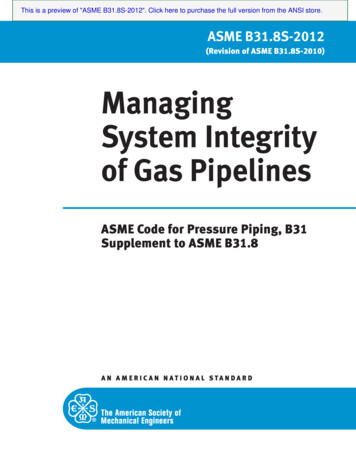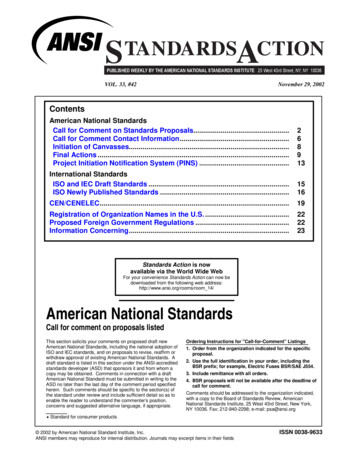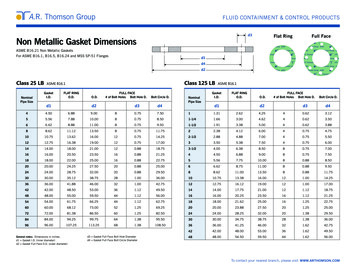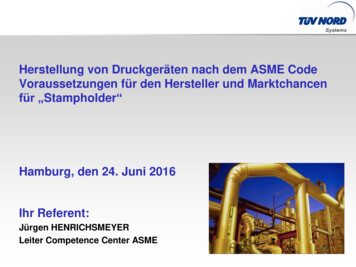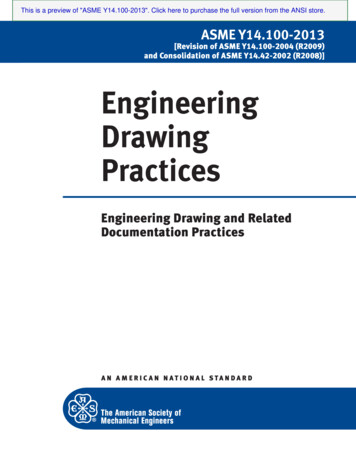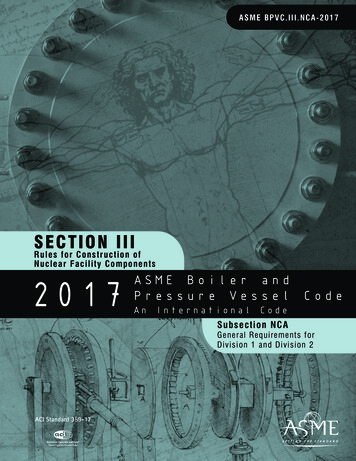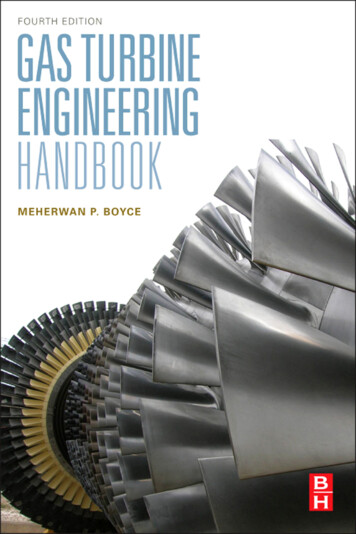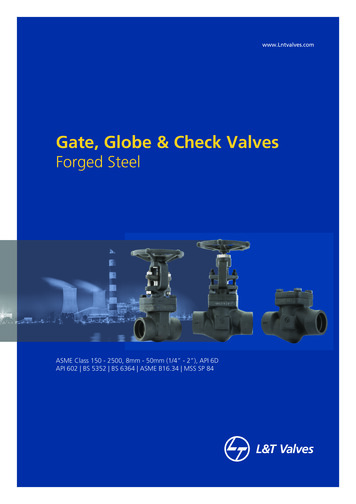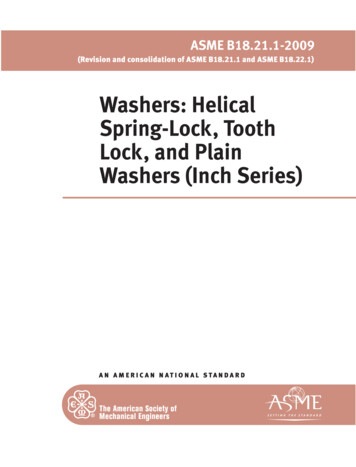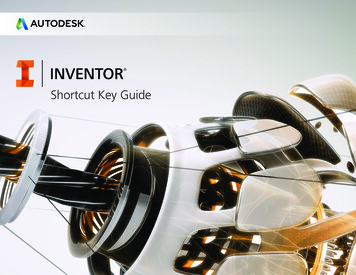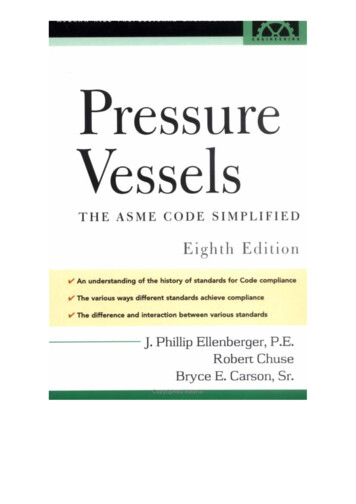
Transcription
Chapter1Origin, Development,and Jurisdictionof the ASME CodeHistory of the ASME CodeOn March 20, 1905, a disastrous boiler explosion occurred in a shoe factory in Brockton, Massachusetts, killing 58 persons, injuring 117 others,and causing a quarter of a million dollars in property damage. For yearsprior to 1905, boiler explosions had been regarded as either an inevitableevil or “an act of God” (see Figs. 1.1 and 1.2). But this catastrophic accident had the effect of making the people of Massachusetts see the necessity and desirability of legislating rules and regulations for theconstruction of steam boilers in order to secure their maximum safety.After much debate and discussion, the state enacted the first legal codeof rules for the construction of steam boilers in 1907. In 1908, the stateof Ohio passed similar legislation, the Ohio Board of Boiler Rules adopting, with a few changes, the rules of the Massachusetts Board.Therefore, other states and cities in which explosions had takenplace began to realize that accidents could be prevented by the properdesign, construction, and inspection of boilers and pressure vessels andbegan to formulate rules and regulations for this purpose. As regulations differed from state to state and often conflicted with one another,manufacturers began to find it difficult to construct vessels for use inone state that would be accepted in another. Because of this lack of uniformity, both manufacturers and users made an appeal in 1911 to theCouncil of the American Society of Mechanical Engineers to correct thesituation. The Council answered the appeal by appointing a committee“to formulate standard specifications for the construction of steam boilers and other pressure vessels and for their care in service.”1
2 Chapter OneFigure 1.1 The Brockton, Massachusetts, shoe factory. (Courtesy of The Hartford SteamBoiler Inspection and Insurance Company.)The first committee consisted of seven members, all experts in theirrespective fields: one boiler insurance engineer, one material manufacturer, two boiler manufacturers, two professors of engineering, and oneconsulting engineer. The committee was assisted by an advisory committee of 18 engineers representing various phases of design, construction, installation, and operation of boilers.Following a thorough study of the Massachusetts and Ohio rulesand other useful data, the committee made its preliminary report in1913 and sent 2000 copies of it to professors of mechanical engineering, engineering departments of boiler insurance companies, chiefinspectors of boiler inspection departments of states and cities, manufacturers of steam boilers, editors of engineering journals, and others interested in the construction and operation of steam boilers, witha request for suggestions of changes or additions to the proposed regulations.After three years of countless meetings and public hearings, a finaldraft of the first ASME Rules for Construction of Stationary Boilersand For Allowable Working Pressures, known as the 1914 edition, wasadopted in the spring of 1915.
Origin, Development, and Jurisdiction of ASME Code 3Figure 1.2 Shoe factory after the boiler explosion of March 20, 1905, which led to the adop-tion of many state boiler codes and the ASME Boiler and Pressure Vessel Code. (Courtesyof The Hartford Steam Boiler Inspection and Insurance Company.)Additions to the CodeSince 1914, many changes have been made and new sections added tothe Code as the need arose. The present sections are listed in the following order:Section I. Power BoilersSection II. MaterialsPart A: Ferrous Material SpecificationsPart B: Nonferrous Material SpecificationsPart C: Specifications for Welding, Rods, Electrodes, and FillerMetalsPart D: PropertiesSection III. Rules for Construction of Nuclear ComponentsSubsection NCA: General Requirements for Divisions 1 and 2Division 1Subsection NB: Class 1 ComponentsSubsection NC: Class 2 ComponentsSubsection ND: Class 3 ComponentsSubsection NE: Class MC ComponentsSubsection NF: Supports
4 Chapter OneSubsection NG: Core Support StructuresSubsection NH: Class 1 Components in Elevated TemperatureServiceAppendicesDivision 2. Code for Concrete ContainmentsDivision 3. Containment Systems for Storage and TransportPackaging of Spent Nuclear Fuel and High Level RadioactiveMaterials and WasteSection IV. Heating BoilersSection V. Nondestructive ExaminationSection VI. Recommended Rules for Care and Operation of HeatingBoilersSection VII. Recommended Guidelines for the Care of Power BoilersSection VIII. Pressure VesselsDivision 1Division 2. Alternative RulesDivision 3. Alternative Rules for Construction of High PressureVesselsSection IX. Welding and Brazing QualificationsSection X. Fiber-Reinforced Plastic Pressure VesselsSection XI. Rules for Inservice Inspection of Nuclear Power PlantComponentsASME Boiler and Pressure Vessel CommitteeThe increase in the size of the Code reflects the progress of industry inthis country. To keep up with this spontaneous growth, constant revisions have been required. The ASME Code has been kept up to date bythe Boiler and Pressure Vessel Committee (currently consisting ofmore than 800 volunteer engineers and other technical professionals)which considers the needs of the users, manufacturers, and inspectorsof boilers and pressure vessels. In the formulation of its rules for theestablishment of design and operating pressures, the Committee considers materials, construction, methods of fabrication, inspection, certification, and safety devices. The ASME works closely with theAmerican National Standards Institute (ANSI) to assure that theresulting documents meet the ANSI criteria for publication asAmerican National Standards.The members of the Committee do not represent particular organizations or companies but have recognized background and experience
Origin, Development, and Jurisdiction of ASME Code 5by which they are placed in categories, which include manufacturers,users of the products for which the codes are written, insuranceinspection, regulatory, and general. The Committee meets on a regular basis to consider requests for interpretations and revisions andadditions to Code rules as dictated by advances in technology.Approved revisions and additions are published semiannually asaddenda to the Code.To illustrate, boilers were operating in 1914 at a maximum pressureof 275 psi and temperature of 600 F. Today, boilers are designed forpressures as high as 5000 psi and temperatures of 1100 F, and pressure vessels for pressures of 3000 psi and over and for temperaturesranging from –350 F to more than 1000 F.Each new material, design, fabrication method, and protective devicebrought new problems to the Boiler Code Committee, requiring theexpert technical advice of many subcommittees in order to expediteproper additions to and revisions of the Code. As a result of the splendid work done by these committees, the ASME Boiler and PressureVessel Code has been developed; it is a set of standards that assuresevery state of the safe design and construction of all boiler and pressurevessels used within its borders and is used around the world as a basisfor enhancing public health, safety, and welfare. Many foreign manufacturers are accredited under the provisions of the ASME Boiler andPressure Vessel Code.Procedure for Obtaining the Code Symboland CertificateUsers of pressure vessels prefer to order ASME Code vessels becausethey know that such vessels will be designed, fabricated, and inspectedto an approved quality control system in compliance with a safe standard. Pressure vessel manufacturers want the Code symbol andCertificate of Authorization so that they will be able to bid for Codework, thereby broadening their business opportunities. They alsobelieve that authorization to build Code vessels will enhance the reputation of their shop.If a company is interested in building Code vessels according to theASME Section VIII, Division 1, Pressure Vessels Code, it shouldacquaint itself with Code Pars. U-2 and UG-92, which outline the manufacturer’s responsibilities and define the requirements for an inspector.This third party in the manufacturer’s plant, by virtue of being authorized by the state to do Code inspection, is the legal representation whichpermits the manufacturer to fabricate under state laws (the ASME Code).Manufacturers who want to construct Code vessels covered bySection VIII, Division 1, obligate themselves with respect to quality
6 Chapter Oneand documentation (see Code Appendix 10, Quality Control Systems).A survey will be required for the initial issuance of an ASMECertificate of Authorization and for each renewal. The evaluation isperformed jointly by the Authorized Inspection Agency and the jurisdictional authority concerned which has adopted, and also administers,the applicable boiler and pressure vessel legislation. When the jurisdictional authority does not make the survey, or the jurisdiction is theinspection agency, the National Board of Boiler and Pressure VesselInspectors will be asked to participate in the survey.After the survey has been jointly made to establish that a qualitycontrol system is actually in practice, the National Board representative, if involved, and the jurisdiction authority will discuss their findings with the manufacturer. If the manufacturer’s system does notmeet Code requirements, the company will be asked to make the necessary corrections. The survey team will then forward its report to theASME with the recommendation that the manufacturer receive theCertificate of Authorization or, if failure to meet standards exists, thatthe certificate not be issued.All Code shops must follow the above procedures in order to obtainthe Code symbol. If your shop wants the Code Certificate of Authorization, you should write to the Secretary of the Boiler and PressureVessel Code Committee, ASME, 3 Park Avenue, New York, NY10016-5990, stating your desire to build such vessels. To help the secretary and the Subcommittee on Code Symbol Stamps evaluate yourshop, the application must describe the type and size of vessel theshop is capable of building and the type and size of your equipment,especially fabricating equipment. If possible, you should arrange withsome Authorized Inspection Agency, such as your state, city, or insurance company, to undertake the inspection service after your shophas received ASME certification. You can then inform the ASME thatspecific inspection arrangements have already been made.The secretary will send a statement of your request to the Subcommittee on Code Symbol Stamps. A request will also be made to the chiefinspector of the particular state, city, or other inspection agency governing your company and/or the National Board of Boiler and PressureVessel Inspectors to make a survey that will determine whether or notyour company has a quality control system that is capable of designingand fabricating pressure vessels by ASME Code rules.The secretary receives a report of this survey and will then forwardthe report to the Subcommittee on Code Symbol Stamps. Should thesubcommittee judge favorably, your company will be issued a Code symbol and Certificate of Authorization. A manufacturer with the ability,integrity, and quality control system to design and fabricate good pressure vessels will have no difficulty in obtaining Code authorization.
Origin, Development, and Jurisdiction of ASME Code 7The National Board of Boiler andPressure Vessel InspectorsThe National Board of Boiler and Pressure Vessel Inspectors, an independent, nonprofit organization whose members are the jurisdictionalofficials responsible for enforcing and administrating the ASME Boilerand Pressure Vessel Code, was first organized in 1919. Since then, ithas served for the uniform administration and enforcement of the rulesof the ASME Boiler and Pressure Vessel Code. In drafting the firstCode, the Boiler Code Committee realized that it had no authority towrite rules to govern administration, and that compliance could bemade mandatory only by the legislative bodies of states and cities.Although some authorities thought that uniformity could beachieved by a code of uniform rules, they proved to be mistaken.Various states and cities adopted the ASME Code with the provisionthat boilers be inspected during construction by an inspector qualifiedunder their own regulations; the boiler was then to be stamped withthe individual local stamping to indicate its conformity with these regulations. This requirement created an unwieldy situation, for boilersconstructed in strict accordance with the ASME Code still had to bestamped with the local stamping, thereby causing needless delay andexpense in delivery of the vessel.It was evident that some arrangement had to be made to overcomesuch difficulties. Therefore, boiler manufacturers met with the chiefinspectors of the states and cities that had adopted the ASME Code andformed the National Board of Boiler and Pressure Vessel Inspectors forthe purpose of presenting the ASME Code to governing bodies of allstates and cities. Their aim was not only to promote safety and uniformity in the construction, installation, and inspection of boilers andpressure vessels but also to establish reciprocity between political subdivisions of the United States. Such ideals could best be carried out bya central organization under whose auspices chief inspectors, or otherofficials charged with the enforcement of inspection regulations, couldmeet and discuss their problems. The efforts of this first group ofadministrators succeeded in extending National Board membership toall Canadian provinces and most of the states and cities of the UnitedStates. It is now possible for an authorized shop to build a boiler orpressure vessel that will be accepted anywhere in the United States orCanada after it has been inspected by an Authorized Inspector holdinga National Board Commission.The ASME Code requires that Inspectors must meet certain minimum requirements of education and experience and must pass a written examination before they can be commissioned to perform Codeinspections. One of the many functions of the National Board is thecommissioning of Authorized Inspectors.
8 Chapter OneShop Reviews by the National BoardBefore the issuance of an ASME Certificate of Authorization to buildCode vessels, the manufacturer must have and demonstrate a qualitycontrol system. This system has to include a written descriptionexplaining in detail the quality-controlled manufacturing process.Before the issuance of renewal of a Certificate of Authorization, themanufacturer’s facilities and organization are subject to a joint reviewby the inspection agency and the legal jurisdiction concerned. For thoseareas where there is no jurisdiction, or where a jurisdiction does notreview a manufacturer’s facility, and/or the jurisdiction is the inspection agency, the function may be carried out by a representative of theNational Board of Boiler and Pressure Vessel Inspectors. When thereview of the manufacturer’s facilities and organization has been madejointly by the inspection agency, and/or the legal jurisdiction, or a representative of the National Board of Boiler and Pressure VesselInspectors, a written report will be sent to the American Society ofMechanical Engineers. The National Board of Boiler and PressureVessel Inspectors also participates in all nuclear surveys.The National Board also issues Certificates of Authorization for theuse of the National Board R stamp, to be applied to ASME Code andNational Board–stamped boilers and/or pressure vessels on whichrepairs are to be made (see the section Welded Repair or AlterationProcedure in this chapter).Another important service the National Board performs is the certification of safety valves and safety relief valves. The ASME Boiler andPressure Vessel Code contains specific requirements governing the design and capacity certification of safety valves installed on Code-stampedvessels. The certification tests are conducted at a testing laboratoryapproved by the ASME Boiler and Pressure Vessel Committee.In addition to safety valve certification, the National Board has itsown testing laboratory for its experimental work and for certifyingASME safety and relief valves. The facilities of the laboratory are alsoavailable to manufacturers and other organizations for research, development, or other test work.National Board RequirementsAll Canadian provinces and most states require boilers and pressurevessels to be inspected during fabrication by an Inspector holding aNational Board Commission and then to be stamped with a NationalBoard standard number. Qualified and authorized boiler and pressurevessel manufacturers must be registered with the National Board ofBoiler and Pressure Vessel Inspectors, 1055 Crupper Ave., Columbus,OH 43229. In addition, two data sheets on each vessel must be filed
Origin, Development, and Jurisdiction of ASME Code 9with the National Board, one copy of which is retained by the Boardand the other sent to the administrative authority of the state, city, orprovince in which the vessel is to be used (see Code Par. UG-120).The National Board of Boiler and Pressure Vessel Inspectors is constantly working to assure greater safety of life and property by promoting and securing uniform enforcement of boiler and pressure vessellaws and uniform approval of designs and structural details of thesevessels, including the accessories that affect their safe operation; byfurthering the establishment of a uniform Code; by espousing one standard of qualifications and examinations for inspectors who are toenforce the requirements of this Code; and by seeing that all relevantdata of the Code are made available to members.In prior years the Uniform Boiler and Pressure Vessel Laws Societyissued a Synopsis of Boiler and Pressure Vessel Laws, Rules, andRegulations, the publishing of which has been assumed by the NationalBoard. The book gives a summary of applicable laws of states,provinces, cities, and counties. It has proved valuable to users andmanufacturers of boilers and pressure vessels. Figures 1.3 and 1.4show political subdivisions of the United States and Canada.Code Case InterpretationsAs the Code does not cover all details of design, construction, and materials, pressure vessel manufacturers sometimes have difficulty ininterpreting it when trying to meet specific customer requirements. Insuch cases the Authorized Inspector should be consulted. If theInspector is unable to give an acceptable answer or has any doubts orquestions about the proper interpretation of the intent of the Code, thequestion can be referred to the Inspector Supervisor’s office. If theInspector and his or her supervisor are not able to provide a ruling,the manufacturer may then request the assistance of the Boiler andPressure Vessel Committee, which meets regularly to considerinquiries of this nature. In referring questions to the Boiler andPressure Vessel Committee, it is necessary to submit complete details,sketches of the construction involved, and references to the applicableparagraphs of the Code; it is also useful to include opinions expressedby others. (See Code Appendix 16 for guidance in preparing inquiriesto the ASME.)Inquiries should be submitted by letter to the Secretary of the Boilerand Pressure Vessel Committee, ASME, 3 Park Avenue, New York, NY10016-5990. (It should be noted that with the advent of the Internet,much of this work can be accomplished through the Web. The ASMEcan be found at www.asme.org.) The secretary will distribute copies ofthe inquiry to the committee members for study. At the next committee meeting, interpretations will be formulated.
10 Chapter OneFigure 1.3 Boiler and pressure vessel laws in the United States and Canada. (Reprintedwith permission of the National Board of Boiler and Pressure Vessel Inspectors,www.nationalboard.org, from National Board Synopsis of Boiler and Pressure VesselLaws, Rules and Regulations, 2003.)These interpretations (issued twice each year) may then becomeaddenda to the Code. If so, they will first be printed in the Addenda supplement of the Code for subsequent inclusion in the latest edition of theCode (printed every three years). Addendas are issued once each year.The addenda incorporate as many case interpretations as possible inorder to keep the open file of cases to a minimum. For their own good,
Origin, Development, and Jurisdiction of ASME Code 11BOILER AND PRESSURE VESSEL CODESFigure 1.4 Tabulation of boiler and pressure vessel codes and stamping requirements inthe United States and Canada. (Reprinted with permission of the National Board ofBoiler and Pressure Vessel Inspectors, www.nationalboard.org, from National BoardSynopsis of Boiler and Pressure Vessel Laws, Rules and Regulations, 2003.)
12 Chapter OneFigure 1.4 (Continued)
Origin, Development, and Jurisdiction of ASME Code 13STAMPING REQUIREMENTSFigure 1.4 (Continued)all Code manufacturers should subscribe to the Code Cases offered bythe American Society of Mechanical Engineers. They will then automatically receive all cases issued by the Boiler and Pressure VesselCommittee, some of which may prove very useful.Canadian Pressure Vessel RequirementsUnited States manufacturers of ASME Code vessels often receiveorders for vessels to be installed in Canada. All provinces of Canada
14 Chapter OneFigure 1.4 (Continued)have adopted the ASME Code and require vessels to be shop-inspectedby an Inspector holding a National Board Commission and to bestamped with a provincial registration number in addition to theASME symbol and National Board stamping.But before construction begins, one important requirement has to bemet in all provinces of Canada. Each manufacturer must submitblueprints and specification sheets in triplicate of all designs forapproval and registration by the chief inspector of the province inwhich the vessel is to be used.After the chief inspector receives the drawings, they are checked byan engineer to determine their compliance with the Code and also withprovincial regulations. If the design does not meet the requirements, areport is sent to the manufacturer, explaining why it cannot beapproved and requesting that the necessary changes be made and thecorrected drawings returned. If the design complies in full, one copy ofthe drawing is returned to the manufacturer with the stamped
Origin, Development, and Jurisdiction of ASME Code 15approval and a registration number that must be stamped on the vessel in addition to the ASME symbol and National Board stamping.Once a design has been approved and registered, any number of vessels of that design can be built and used in the province where it isapproved. If a vessel of the same design is to be sent to anotherCanadian province, the manufacturer’s letter to the chief inspector ofthat pro-vince should state the registration number of the originalapproval. The second province will then use the same registrationnumber with the addition of its own province number. For example, adesign first registered in Ontario might have been given the number764. This number would be followed by a decimal point and then thenumber 5, which signifies the Province of Ontario. The registrationwould thus be 764.5. If this same design were used in the Province ofManitoba, it would be given the registration number 764.54, with thefigure 4 denoting Manitoba.The Canadian provinces also require their own manufacturer’s affidavit form, with the registration number and the shop inspector’s signature on the data sheets. Finally, when a vessel is delivered to a purchaserin Canada, an affidavit of manufacture bearing the registration numberand the signature of the authorized shop inspector must be sent to thechief inspector of the province for which it is intended.Department of Transportation RegulationsA new Chapter 11 in this book explains clearly the new federal regulations 49 CFR Parts ¶107, ¶178, and ¶180, formerly known as docketsHM-183 and HM-183A. This new regulation mandates and requiresthat all over-the-road specification cargo tank trucks be manufacturedby a holder of an ASME Code symbol U stamp. Most of these cargo tanktrucks will not bear the official ASME Code stamp; however, certainspecification cargo tanks will be manufactured and continue to bestamped ASME if all the requirements of the Code are met. Additionallyand most importantly, all specification cargo tanks will now be requiredto be repaired by the holder of a National Board R stamp.These new regulations will require numerous companies to obtainthe ASME U Code symbol stamp or the National Board R symbolstamp. Quality control programs will be required when no such programs have existed in the past. Training of personnel will now beinvolved in areas of nondestructive examination, testing, procedurequalification, and numerous other areas involving quality. This willcause additional expense to the facilities involved. New maintenanceactions involving periodic tests and inspections are also mandated andmust be carried out.
16 Chapter OneWelded Repair or Alteration ProcedureRepairs or alterations of ASME Code vessels may be made in any shopthat manufactures Code vessels or in the field by any welding contractorqualified to make repairs on such vessels. Recognizing the need for rulesfor repair and alterations to boilers and pressure vessels, the NationalBoard of Boiler and Pressure Vessel Inspectors in their inspection code,Chapter III, gives rules that many states have incorporated into theirown boiler and pressure vessel laws. Many companies have been usingthese rules as a standard for repairs to pressure vessels.The National Board also has six Certificates of Authorization for useof the National Board R stamp. Any repair organization may obtainCertificates of Authorization for use of the National Board R stamp tobe applied to ASME Code and National Board–stamped boilers and/orpressure vessels on which repairs have been made.Before an R stamp is issued, the firm making repairs must submit toa review of its repair methods. It must also have an acceptable writtenquality control System covering repair design, materials to be used,welding procedure specifications, welders’ qualifications, repair methods, and examination. The review will be made by a National Boardmember jurisdiction where the repair company is located. If there is noNational Board member jurisdiction, or, at the request of such jurisdiction, the review will be made by a representative of the National Board.Manufacturers and assemblers who hold ASME Certificates ofAuthorization and Code stamps, with the exception of H (cast iron), V,UV, and UM stamps, may obtain the National Board R stamp withoutreview provided their quality control system covers repairs.Whenever the R stamp is to be applied to National Board–stampedboilers and pressure vessels, all repairs are subject to acceptance by anInspector who holds a valid National Board Commission and a validCertificate of Competency issued by a state or jurisdiction of the UnitedStates or Province of Canada.The Authorized Inspector will be guided by the National BoardInspection Code* as well as by any existing local rules governing repairof vessels. When the work is to be done on location, repairs to a vesselrequire greater skill than was required when the vessel was first shopconstructed. Utmost consideration must be given to field repairs, whichmay necessitate cutting, shaping, and welding with portable equipment. The practicability of moving the vessel from the site to a properlyequipped repair shop should be considered. Before repairs are made,the method of repair must be approved by an Authorized Inspector. The*The Code is published by the National Board of Boiler and Pressure Vessel Inspectors,1055 Crupper Ave., Columbus, OH 43229.
Origin, Development, and Jurisdiction of ASME Code 17Inspector will examine the vessel, identify the material to be welded,and compare it with the material to be used in repair. A check is thenmade to ensure that the welding contractor or shop has a qualifiedwelding procedure for the material being welded and that the welderwho does the work is properly qualified to weld that material. If therepair or alteration requires design calculations, the Inspector willreview the calculations to assure that the original design requirementsare met. For repair of Section VIII, Division 2 pressure vessels, thedesign calculations must be reviewed and certified by a RegisteredProfessional Engineer experienced in pressure vessel design.When the repairs or alterations and the necessary tests have beencompleted, one or more of the following reports are filled out (see Fig.1.5): Form R-1, Report of Welded Repair; Form R-2, Report ofAlteration; and Form R-3, Report of Parts Fabricated by Welding.(Form R-4, Report Supplementary Sheet, should be used for any information for which there is not enough room on one of the other threeforms.) Some states and insurance companies have their own formswhich must be signed by the contractor or manufacturer making therepair and by the Authorized Inspector.When an alteration is made to a vessel, it shall comply with the section of the ASME Code to which the original vessel was constructed toconform. The required inspection shall be made by an AuthorizedInspector holding a National Board Commission. No alteration shall beinitiated without the approval of the Authorized Inspector.When alterations are completed, Form R-2 shall be signed and certified, indicating that the alteration has met the applicable requirements.This R-2 report shall record the required data and shall clearly indicatewhat changes or alterations have been made to the original construction.On the R-2 report, under Remarks, the name of the original manufacturer, manufacturer's serial
ASME Section VIII, Division 1, Pressure Vessels Code, it should acquaint itself with Code Pars. U-2 and UG-92, which outline the manu-facturer’s responsibilities and define the requirements for an inspector. This third par
